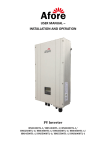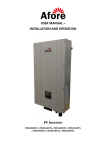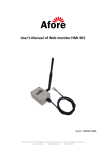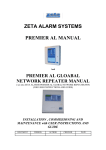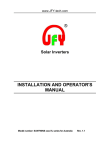Download user manual and specification sheet
Transcript
USER MANUAL – INSTALLATION AND OPERATION PV Inverter HNS1000TL-1/ HNS1500TL-1/ HNS2000TL-1/ HNS2500TL-1/ HNS3000TL-1/ HNS3600TL-1/ HNS4000TL-1 About Afore Afore New Energy Technology (Shanghai) Co., Ltd., located in the Hi-Tech PV center of Shanghai, China, is an international PV enterprise, which is specialized in manufacturing of solar PV inverters. Afore is dedicated to providing perfect power conversion and control solutions for solar power generation installations R&D, manufacturing and marketing of solar PV inverters. Afore possesses the first-class production equipment and international R&D team. The core business is to provide all kinds of high-quality and reliable grid-connected solar Inverters and energy system solutions to satisfy the consistently increasing demands for global energy. The newly designed PV Inverter features itself with full load high efficiency, high reliability and user-friendly interface. The conversion efficiency of our inverter is up to 97%. A user-friendly installation & interface, professional industrial design, and design for reliability mechanism, give the Inverter Family a competitive edge for customers from all regions. As a customer-oriented company, Afore is always trying to improve itself and enhance customer satisfaction. High quality is the fountain of life for Afore, not just in product quality control, but in quality of service and support. AFORE is able to help customers reduce energy consumption and carbon dioxide emissions by leading green solutions. Contents 1 About This Manual .................................................................................................................... 1 1.1 Scope of Validity ................................................................................................................ 1 1.2 Target Group ...................................................................................................................... 1 1.3 Additional Information ................................................................................................... 1 2 Safety Instructions..................................................................................................................... 1 2.1 Safety Precautions ............................................................................................................ 1 2.2 Explanations of Symbols................................................................................................. 2 3 Unpacking...................................................................................................................................... 3 3.1 Assembly Parts................................................................................................................... 3 3.2 Identifying the Inverter .................................................................................................. 4 4 Mounting ........................................................................................................................................ 4 4.1 Selecting the Appropriate Mounting Location ....................................................... 4 4.2 Mounting the Inverter with Wall Mounting Bracket ........................................... 5 5 Electrical Connection................................................................................................................ 6 5.1 Overview of the Connection Area ............................................................................... 6 5.2 Connection to the Public Grid (AC) ............................................................................ 8 5.2.1 Conditions for the AC Connection .................................................................. 8 5.2.2 Connecting to the Public Grid (AC) ................................................................ 8 5.3 Connection of the PV Generator (DC) .....................................................................11 5.3.1 Conditions for the DC Connection ................................................................12 5.3.2 Assembling the DC Plug Connector .............................................................12 5.3.3 Connecting the PV Generator (DC) ..............................................................14 6 System Diagram ........................................................................................................................14 7 Operation .....................................................................................................................................14 7.1 Overview of Controls and Display .............................................................................16 7.2 Commissioning ................................................................................................................17 7.3 LED Display .......................................................................................................................17 7.4 LCD Display .......................................................................................................................18 8 Auto Test.......................................................................................................................................22 9 Trouble Shooting ......................................................................................................................27 10 Technical Data.........................................................................................................................32 11 Contact ........................................................................................................................................34 1 About This Manual 1.1 Scope of Validity This manual describes the assembly, installation, commissioning, operation and maintenance of the following ANYHOME series grid-connected PV inverters produced by Afore New Energy: • HNS1000TL-1 • HNS1500TL-1 • HNS2000TL-1 • HNS2500TL-1 • HNS3000TL-1 • HNS3600TL-1 • HNS4000TL-1 Please keep this manual all time available in case of emergency. 1.2 Target Group This manual is for qualified personnel. The tasks described in this manual must only be performed by qualified personnel. 1.3 Additional Information Further information on special topics, such as description of parameters and measurement readings, can be downloaded in the download area at www.aforenergy.com. 2 Safety Instructions 2.1 Safety Precautions 1. All work on the inverter must be carried out by skilled electricians. And ensure that children do not play with the equipment. 2. The device may only be operated with PV generators. Do not connect any other source of energy to the device. 3. The PV generator and inverter must be connected to the ground in order to reach maximum protection for property and persons. 4. Do not remove cover until 3 minutes after disconnecting all sources of supply. This 1 / 34 is because the charge stored in capacitors may provide a risk of electric shock or a risk of electrical energy-high current level. 5. The enclosure of Inverter can become hot during operation. To reduce the risk of injury, do not touch the cover, heat sink at the back of the PV-Inverter or nearby surfaces while Inverter is operating. 6. Do not use the equipment for purposes other than those described in this manual. 7. Both the inverter and associated transport packaging are mainly made of recyclable raw materials. Please ensure that the used device and any relevant accessories are disposed of in accordance with applicable regulations. 2.2 Explanations of Symbols Symbol Explanation Danger of Electric Shock. The inverter is directly connected with the public grid. All work on the inverter must be carried out by qualified personnel only. Beware of hot surface. The inverter can become hot during operation. Do not contact the device during operation. Caution, risk of electric shock Energy storage timed discharge, time to be indicated adjacent to the symbol. Caution, Danger. This device directly connected with electricity generators and public grid. Do not dispose of this device with the normal domestic waste. Without Transformer. This inverter does not use transformer for the isolation function. CE mark. The inverter complies with the requirements of the applicable EC guidelines. C-Tick mark. The inverter complies with the requirements of Australian Communications Authority guidelines. Notes, Important. Non-adherence to these instructions may adversely affect the operating convenience or functionality of the device. 2 / 34 3 Unpacking 3.1 Assembly Parts Please check the delivery for completeness and any visible external damage. Contact your dealer at once if anything is damaged or missing. Object Quantity Description Object Quantity Description A 1 Solar inverter B 1 Wall mounting bracket C 1 User manual D 1 Certificate of Inspection E 1 F 1 set/ 2 sets* DC plug connector G 3 Pre-insulation terminal H 3 Plastic Expansion Tube I 3 Tapping screw Warranty Card is included in the installation manual *1 set for HNSxxxxTL-1 (xxxx=1000, 1500, 2000, 2500) 2 sets for HNSxxxxTL-1 (xxxx=3000, 3600, 4000) 3 / 34 3.2 Identifying the Inverter You can identify the inverter using the type label. Information such as serial number (Serial No.) and type of the inverter, as well as device-specific characteristics are specified on the type label. The type label is on the right side of the enclosure. 4 Mounting DANGER! Danger to life due to potential fire or electric shock. Do not install the inverter near any inflammable or explosive items. The inverter will be directly connected with high voltage power generation device. The installation must be performed by qualified personnel only in compliance with national and local standards and regulations. CAUTION! Danger of burn injuries due to hot enclosure parts. •Install the inverter so that it cannot be touched inadvertently. Risk of injury due to the heavy weight of the inverter. • Take the inverter's weight of approx. 16 kg into account for mounting. 4.1 Selecting the Appropriate Mounting Location Consider the following points when selecting where to install: • The mounting method and location must be suitable for the inverter's weight and dimensions. • Mount on a solid surface. But do not mount the unit on plasterboard walls or similar in order to avoid audible vibrations for the inverter can make noises when in use. 4 / 34 • Vertical installation or tilted backward by max. 30 degree is allowed. • Never mount the device with a forward tilt, horizontally or even upside down • For the convenience of checking the LCD display and possible maintenance activities, please install the inverter at eye level. • The ambient temperature of installation site should be between -20 °C and +55 °C (between -4 °F and 131 °F). • Install the inverter directly exposes to strong sunshine is not recommended, the excess heating might lead to power reduction. • Provide better ventilation for the inverter to ensure that the heat is dissipated adequately. • The site altitude of installation should be below 1000m above sea level; more than 1000m above the sea level will cause derating. 4.2 Mounting the Inverter with Wall Mounting Bracket 1. Use the wall mounting bracket as a drilling template and drill the holes for the screws. 2. Fix the wall mounting bracket to the wall using appropriate screws (diameter min. 5 / 34 6 mm, max. 8 mm) and washers (outer diameter min. 12 mm, max. 24 mm). 3. Hang the inverter to the mounting bracket and ensure the slot is fitted on the bracket. 4. Check to ensure the inverter is correctly seated. Make sure to lock it with the safety-lock screws on both sides to ensure the inverters, see the figure below.) 5 Electrical Connection Notes: 1. After the inverter has been installed in its fixed position, the electrical connection to the unit can be established. 2. Make sure Max. Open Voltage and short-circuit current of the each PV strings accord with the Spec. 3. Choose the appropriate cable width for AC/DC wire. 4. To connect the inverter, the AC and DC sides must be disconnected from all power sources and secured against being inadvertently switched back on. 5. Before connecting the inverter to PV arrays and public grid, make sure the polarity is correct. 5.1 Overview of the Connection Area The following figures show the assignment of the individual connection areas on the bottom of the inverter. 6 / 34 Apply to HNSxxxxTL-1 (xxxx=1000, 1500, 2000, 2500) Apply to HNSxxxxTL-1(xxxx=3000, 3600, 4000) Object Description A DC connectors ( + ) for connecting the PV strings B DC connectors ( − ) for connecting the PV strings C Waterproof connector for the communication connection (RS485 Quick Module) D Waterproof connector for the AC connection E Cover plate for RS485 connection and AC connection F Switch(optional) 7 / 34 5.2 Connection to the RS485 and Public Grid (AC) 5.2.1 Conditions for Connection CAUTION! Load Disconnection Unit An individual circuit breaker should be equipped for each inverter in order that the inverter can be safely disconnected under load. 5.2.2 Connection to the RS485 and Public Grid (AC) Measure the grid voltage, make sure it within the permissible range. Disconnect the circuit breaker between the invert and the grid. Strip the insulation sheet of wire cable about 12mm length, sleeve the pre-insulation terminal on the cable, as shown in the following figures. Loosen the screws, then open the cover plate gently, pull out the network connector for convenient operation. Two holes will turn up after loosen the waterproof connector (C&D). Then thread the 3 electric wires through the right one (D), and thread the communication line through the left one(C). Please refer to the following figure. 8 / 34 The following figure shows the assignment of the individual connection areas on the reverse side of the cover plate. Connection to the Public Grid: Loosen the screw to end in counter-clockwise, insert the cable with tube into the socket, then tighten the scew to end in clockwise. make sure the wires are securely connected. 9 / 34 According to polarities, connect the grounding line to PE terminal; the neutral line to N; and phase line to L. as shown in the following figure. Communication via RS485(optional): Only twisted-pair cable (or AB cable) apply to the communication connection. There are 4 pins for communication connection, as shown in the figure, and they are defined as follows: Pin1 Pin2 Pin3 Pin4 +5V 485A 485B GND Pin 1 and pin4 is only used when communication is realized through wireless communication module. Connect Pin 2, Pin 3 if communication is realized through RS485. RS485 can be used for multipoint communication. Up to 31 inverters can communicate and be monitored through one communication module. RS485 communication module and receiver can be purchased from Afore New Energy as options. And relevant monitoring software can be downloaded from www.aforenergy.com. 10 / 34 Do not forget to insert the network connector back into the plug before close the cover plate. Close the cover plate and tighten the waterproof connector (C&D) and the screws. 5.3 Connection to the PV Generator (DC) CAUTION! Load Disconnection Unit On the DC side out of inverter there is a circuit breaker (optional), in order that the inverter can be safely installed, the circuit breaker must be switched off. 11 / 34 5.3.1 Conditions for the DC Connection • The connected PV modules must meet following requirements – Same type – Same number – Identical alignment – Identical tilt • The following limit values at the DC input of the inverter must not be exceeded (connecting to a higher voltage will destroy the device): Anyhome Maximum input voltage Maximum input current HNS1000TL-1 450V 6A HNS1500TL-1 450V 8A HNS2000TL-1 500V 12A HNS2500TL-1 500V 14A HNS3000TL-1 550 17A HNS3600TL-1 550 18A HNS4000TL-1 550 20A 5.3.2 Assembling the DC Plug Connector In order to connect to the inverter, all connection cables of the PV modules must be equipped with the DC plug connectors provided. You will find the necessary DC plug connector for DC connection in the delivery. To assemble the DC plug connectors, proceed as detailed below. Ensure the plug connectors have the correct polarity. The whole connector will include the male side and female side as showed below. 12 / 34 Male side connector(M) Female side connector(F) Assembly Instructions: 1. Adjust the striper stopper and put the cable in corresponding notch to strip the length of 12mm. Please refer to the following figures. 2. Insert striped cable into contact barrel and insure all conductor strands are captured in the contact barrel. 3. Compress them together with the crimping pliers. 4. Insert contact cable assembly into back of male and female connector. A “click” should be heard or felt when the contact cable assembly is seated correctly. Then turn the cap to the coupler. Please refer to the following figures. 13 / 34 5.3.3 Connecting the PV Generator (DC) DANGER! Danger to life due to high voltages in the inverter. • Before connecting the PV generator, ensure that the AC&DC circuit breaker is switched off and that it cannot be reactivated. Notes: 1. Disconnect the circuit breaker. 2. Check the connection cables of the PV modules for correct polarity and that the maximum input voltage of the inverter is not exceeded. 3. Check the DC plug connector for correct polarity and connect it. Plug the DC plug connector to DC terminal on inverter. Apply to HNSxxxxTL-1(xxxx=1000,1500,2000,2500) Apply to HNSxxxxTL-1(xxxx=3000,3600,4000) 14 / 34 6 System Diagram The typical connection diagram for the entire PV system is shown in the following figure. 1. PV Panel: Provide DC power to inverter 2. Inverters: Converts DC (Direct Current) power from PV panel(s) to AC (Alternating Current) power. Because Inverter is grid-connected it controls the current amplitude according to the PV Panel power supply. Inverter always tries to convert the maximum power from your PV panel(s). 3. Connection system: This “interface” between Utility and PV-Inverter may consist of electrical breaker, fuse and connecting terminals. To comply with local safety standards and codes, the connection system should be designed and implemented by a qualified technician. 4. Utility: Referred to as “grid” in this manual, i.e. the way your electric power company provides power to your place. Please note that Inverter can only connect to low-voltage systems (namely, 220, 230VAC, 50Hz). 15 / 34 7 Operation Product Overview 7.1 Overview of Controls and Displays 16 / 34 There are four function keys on the front panel (from left to right): Esc, Up, Down, Enter. The keypad is used for: Scroll the displayed parameter(Up and Down keys); Accessing and modifying the adjustable parameters (Esc and Enter keys). 7.2Commissioning After completing the mechanical and electrical installation, the inverter is put into operation. 1. Switch on the DC and AC breakers. The inverter starts up automatically when the power from PV generator is sufficient. 2. Check whether the display and LEDs are indicating a normal operating state. A Green Glowing, operation B Red & LCD backlight Flashing, contact installer 7.3LED Display The inverters are equipped with two LEDs including “green” and “red” which provide information about various operating states in the following ways. They are marked with “Power” and “Fault”, respectively. When the inverter is power on from the generator and operating correctly, the green LED is on. The red light is flashing during the inverter is operating correctly indicates a fault in the system or inverter, and the LCD display provides the exact information. LED DC Power in (green): The green LED is illuminated from a generator voltage of approx. 120V onward and extinguishes as soon as the generator voltage falls below 100V. The DC Power in LED signals that the inverter is in its active state and the inverter controls are enabled. If this LED is not lit up which means the inverter will not be able to start grid feeding. Under normal operating conditions the LED is illuminated in the morning when there is enough daylight, and extinguishes again when it gets dark. Under normal operating conditions the inverter starts grid feeding in the morning and terminates this process as it becomes dark. This process might be repeated several times throughout the day, especially in the morning and evening. This is not a 17 / 34 sign of faulty operation but is normal operating behavior. Fault LED (red): This LED indicates that the grid-feeding process has been terminated as a result of a malfunction. Please wait for about 10 minutes to verify if the malfunction is only temporarily. If not, please contact your authorized electrician. On elimination of the error the grid feeding process is re-started after about 5 minutes. In the event of a fuse failure please contact your authorized electrician. In case of a general power grid failure please wait until the problem has been resolved. The inverter will restart automatically. 7.4 LCD Display A backlight LCD display is integrated into the inverter so that it can be easily visible. Inverter starts up automatically when DC-power from the PV panel is sufficient. During startup (the green led is illuminated), the LCD shows logo of company and version of inverter. The LCD will be initialized for 3 seconds. In the normal operation status, the display will show the default menu as follow: 7.4.1 LCD Display All content shows in the LCD by default: Power The current output power (W) 18 / 34 Ipv The present current of the solar generator (A) Vpv The present voltage of the solar generator (V) Iac The present grid current (A) Vac The grid voltage (V) EToday The energy generated today in kilo watt hours (KWh) ETotal The energy generated since starting up the inverter (KWh) RunTim The time since the energy generated today (minutes) SumTim The total time since starting up the inverter (hours) The current information occurring on the PV inverter The current time & date Ipv, Vpv, Iac, Vac, EToday, Etotal, RunTim, SumTim in the block diagram will be shown one by one with default 3s interval. Screens can be scrolled manually by pressing the ‘Up’ key. Along with the different working states of the inverter, the line of current information will display different state information as follow: Display Description Wait Initialization & Waiting MPPT Power generation Power Limited Operation The inverter only can be operated under the rated power Hot Limited power operation caused by over temperature EEPROM Failure Internal device fault Para Over Range Internal parameter over range Ref Voltage Error Reference voltage error Vac Sensor Fail Grid voltage sensor failure Iac Sensor Fail Grid current sensor failure Ipva Sensor Fail A fault has occurred in current sensor of the inverter. GFCI Failure GFCI sensor failure AC Fuse-Check Fail Fuse of the grid-side melted AC Relay-Check Fail Relay of the grid-side failure PVA Over Voltage PV voltage exceeds permitted values. Busbar Over Voltage The Bus voltage of PV strings exceeds permitted values. Utility Loss No utility or power off Vac Over Voltage Grid voltage high 19 / 34 Vac Under Voltage Grid voltage low Fac Over Range Grid Frequency over limited Grid Islanding Grid voltage Islanding Fault PDP Internal device (PDP module) fault GFCI Activation The inverter has detected a ground fault in the PV generator. DC INJ High The alternative component of the DC current is out of the permitted range. AC Over Current Grid current is over range. PVA Over Current PV current exceeds permitted values. Over Temperature The temperature of inverter is over 85℃. RS485 Failure RS485 represent communication module. RTC Failure Real time clock failure (In the state of Fault, the red LED will flash. In most situations, the inverter requires very little service. However, if inverter is not able to work perfectly, you can check more details in the chapter ‘9 Trouble shooting’) 7.4.2 Main Menu Press the ‘Esc’ key to enter the main menu. The main menu contains 5 submenus as follow: Press the ‘up’ & ‘down’ keys to select the submenu. When chosen item is selected, press ‘Enter’ key to open the submenu. Pressing the ‘ESC’ key calls back the Main menu. Display Info The interface of ‘Display Info’ shows all the parameters that the inverter in the normal operation status. The pattern of the interface is as same as the default menu after the LCD is initialized. As the follow figure: 20 / 34 Device Info Press ‘Enter’ to open the submenu ‘Device Info’. This submenu contains these follow information: Rated power, Rated current, Rated voltage, Rated frequency, Busbar voltage, Cooler Temperature, Case temperature. Screens can be scrolled manually by pressing the ‘Up’ & ‘Down’ keys. History Info Press ‘Enter’ to open the submenu ‘History Info’. ‘History Info’ records the fault information group and it records the fault parameter in detail. Screens can be scrolled manually by pressing the ‘Up’ & ‘Down’ keys. Advanced Info ‘Advanced Info’ refers to the password. Type in the correct password (The password can be altered manually by pressing the ‘Up’ and ‘Down’ keys, then press the ‘Enter’ key to confirm). For safety usage and do not affect the efficiency of the inverter, this submenu should be operated by the authorized electrician only. Pressing ‘Esc’ calls back the main menu. Date/Time Adj. 21 / 34 To ensure the correct statistical results of ‘day power’, please make sure the system time is set to local time. Press ‘Enter’ to get access to the ‘Date/Time Adj.’. Set the time by the procedure below. Pressing ‘Down’ to choose the option, and then use ‘Up’ key to set the number. After adjusting the time and date, pressing ‘Enter’ to confirm and save, the interface will show the figure as below. Press ‘Enter’ again the interface will return to the previous main menu. Pressing ‘Esc’ if cancel. 8 Auto Test The ‘Auto test’ can be download from Afore company’ website www.aforenergy.com. The auto-test function is stipulated in accordance with the Italian Standard CEI 0-21. It will enable verification of the voltage and frequency monitoring function. 8.1 The auto-test can be started by any user. 8.2 The auto-test software shall be installed in a PC that will communicate to the PV grid-connected inverter through the “485 port”. For the overall duration of the auto-test, the grid-connected inverter doesn’t export power to the AC grid. And meanwhile make sure the inverter was connected to the PV arrays, and the inverter was generating. 8.3 After clicking the icon , the interface will be displayed on the PC screen. 22 / 34 8.4 Clicking the “Open” button, it will communicate to the PV grid-connected inverter through the “485 port”. 8.5 Then clicking the “Connect” button, the interface will be displayed as followings if successfully connecting. And meanwhile you should ensure the inverter is safely connected to the utility. 8.6 And the AC grid voltage, the AC grid frequency and the AC current of the grid-connected inverter will be shown in the PC screen. 8.7 If the connecting is failed, repeat the step 4 to the step 5 until successfully 23 / 34 connecting. 8.8 The values of the thresholds and software trip time for the grid voltage and the grid frequency related to the auto test can be set. The default parameters are as follows: Max Vac (Maximum AC voltage threshold): 264.5V; ≤0.2s Min Vac (Minimum AC voltage threshold): 92V; ≤0.2s Max Fac (Maximum AC frequency threshold): Min Fac (Minimum AC frequency threshold): 51.5Hz; <0.1s 47.5Hz; <0.1s 8.9 If all values are correct then the user can be able to click the “SET” button on the PC screen to set the auto-test parameters. The interface will be displayed on the PC screen as followings if successfully set. 8.10 After setting the values of the auto-test, there are four mode selections to test the auto-test and the user can only select one mode for every time. After selecting the mode, the user can click the button “Start” to start the auto-test. And if clicking the “stop” button, the auto-test will stop. For example, if the user selects the MaxV mode and clicks the button “Start”, the following will be shown on the PC screen. 24 / 34 8.11 The slew rate of the threshold values , either increase or decrease, are equal or less than 0.05Hz/s for AC grid frequency and equal or less than 1V/s for AC grid voltage starting from the maximum (or minimum) threshold value. During the auto-test, the threshold value changes linearly and the measured values of the grid will be displayed on the PC screen in real time. The threshold will move from the maximum (or minimum) threshold value toward the measured value of the AC grid. While the two value matching occurs, the PV grid-connected inverter will disconnect the AC grid through the AC relays. 8.12 The matched value between the threshold and the AC grid and the software trip time between the matching is recognized and the AC relays is open will be displayed on the PC screen. The status of the each auto-test, Pass or Fail, will also be displayed on the PC screen as well. The following will be shown on the PC screen if selecting the MaxV mode. 25 / 34 8.13 If firstly click the “Disconnect” button and then click the “Exit” button, the auto-test will stop and the interface on the PC screen will exit. Note: The results will be saved as an Access file after the auto-test process is completed 26 / 34 9 Trouble Shooting In most situations, the inverter requires very little service. However, if inverter is not able to work perfectly, we recommend the following solutions for quick troubleshooting. No. 1 2 3 If there is a fault, the red LED will flash. Please refer to the following table for a list of potential problems and their solutions. Definition Error Message PVA over voltage PVa Over Voltage PN over voltage Ground-fault current protection Busbar Over Voltage Active GFCI Possible Causes 1. The open-circuit voltage of PV panels exceeds permitted values. Inverter fault 1. The connection of grounding wires of PV panels is incorrect. 2. The connection of AC grounding wires of PV panels is incorrect. EEPROM Failure 5 Parameter error Para Over Range Inverter fault 6 Reference voltage error Ref Voltage Error Check the wire connection Check the wire connection Restart the inverter; if the error still remains after repeated restarting, please contact our after-sales. Restart the inverter; if the error still remains after repeated restarting, please contact our after-sales. Restart the inverter; if the error still remains after repeated restarting, please contact our after-sales. Restart the inverter; if the error still remains after repeated restarting, please contact our after-sales. 3. Inverter fault EEPROM error Adjust the PV panel configuration Restart the inverter; if the error still remains after repeated restarting, please contact our after-sales. Restart the inverter; if the error still remains after repeated restarting, please contact our after-sales. 2. Inverter fault 4 Corrective Measure Inverter fault Inverter fault 27 / 34 7 8 9 10 AC voltage sensor failure AC current sensor failure PVA current sensor failure Ground-fault current interrupter failure 11 AC fuse blew out 12 AC relay failure 13 PDP protection Vac Sensor Fail Inverter fault Iac Sensor Fail Inverter fault Ipva Sensor Fail Inverter fault GFCI Failure Inverter fault AC Fuse-Check Fail AC Relay-Check Fail Fault PDP Restart the inverter; if the error still remains after repeated restarting, please contact our after-sales. Restart the inverter; if the error still remains after repeated restarting, please contact our after-sales. Restart the inverter; if the error still remains after repeated restarting, please contact our after-sales. Restart the inverter; if the error still remains after repeated restarting, please contact our after-sales. Restart the inverter; if the error still remains after repeated restarting, please contact our after-sales. Restart the inverter; if the error still remains after repeated restarting, please contact our after-sales. Restart the inverter; if the error still remains after repeated restarting, please contact our after-sales. Inverter fault Inverter fault Inverter fault 1. The grid fluctuates too sharply. 14 DC current protection DC INJ High 2. Inverter fault 1. The grid fluctuates too sharply. 15 16 AC over current PVA over current AC Over Current PVa Over Current 2. Inverter fault When the grid returns to normal, the inverter restores automatically. Restart the inverter; if the error still remains after repeated restarting, please contact our after-sales. The inverter restores automatically. Restart the inverter; if the error still remains after repeated restarting, please contact our after-sales. 1. The external conditions, such as the PV voltage and the sunlight, change too sharply. The inverter restores automatically. 2. Inverter fault Restart the inverter; if the error still remains after repeated restarting, please contact our after-sales. 28 / 34 17 Over temperature protection Over Temperature 1. The external conditions, such as the PV voltage and the sunlight, change too sharply. 2. Inverter fault 18 19 20 Islanding protection Grid loss Grid over voltage Grid Islanding Utility Loss Vac Over Voltage 1. The grid is abnormal. 2. Ratings of the grid-side switch do not meet the grid requirements so that the switch has tripped. 3. AC connectors are in poor connect. The inverter restores automatically. Restart the inverter; if the error still remains after repeated restarting, please contact our after-sales. When the grid returns to normal, the inverter restores automatically. Replace the switch. Reconnect the connectors again. 4. Inverter fault Restart the inverter; if the error still remains after repeated restarting, please contact our after-sales. 1. The grid is abnormal. When the grid returns to normal, the inverter restores automatically. 2. Ratings of the grid-side switch do not meet grid requirements so that the switch has tripped. 3. AC connectors are in poor connect. Replace the switch. Reconnect the connectors again. 4. Inverter fault Restart the inverter; if the error still remains after repeated restarting, please contact our after-sales. 1. The grid is abnormal. When the grid returns to normal, the inverter restores automatically. 29 / 34 21 22 23 24 25 Grid under voltage Grid frequency error LCD screen do not light up/ Green LED glows. Output power is half of the Max. Power. GFCI tripped Vac Under Voltage 2. Inverter fault When the grid returns to normal, restart the inverter; if the error still remains after repeated restarting, please contact our after-sales. 1. The grid is abnormal. When the grid returns to normal, the inverter restores automatically. When the grid returns to normal, restart the inverter; if the error still remains after repeated restarting, please contact our after-sales. 2. Inverter fault 1. The grid is abnormal. When the grid returns to normal, the inverter restores automatically. 2. Inverter fault When the grid returns to normal, restart the inverter; if the error still remains after repeated restarting, please contact our after-sales. Inverter fault When the grid returns to normal, restart the inverter; if the error still remains after repeated restarting, please contact our after-sales. 1. All the PV panels are connected to the inverter as one input string. Change the installation. 2. Inverter fault When the grid returns to normal, restart the inverter; if the error still remains after repeated restarting, please contact our after-sales. Fac Over Range NC NC NC 1. The connection of grounding wires of PV panels is incorrect. 2. The connection of AC grounding wires of the inverter is incorrect. 3. GFCI is shared by both the inverter and other equipments. 30 / 34 Check the installation Check the installation Check the installation 4. GFCI failure Replace the switch Restart the inverter; if the error still remains after repeated restarting, please contact our after-sales. 5. Inverter fault 26 Isolation failure Isolation failure 1.PV(+) or PV(-) is earthed Check the impedance between PV(+)& PV(-) 2.PV-inverter is not earthed Make sure the PV-Inverter is earthed 3. Inverter fault Restart the inverter; if the error still remains after repeated restarting, please contact our after-sales. Restart: Disconnect all the input and output switches, wait until the LCD screen and all the indicating lights go off, and then reconnect all the switches again. If there is no display on the panel, please check PV-input connections. If the voltage is higher than 120 V, and the inverter doesn’t work, please call local service. If it is intended to replace the cable or open the enclosure lid, please call our service. During periods of little or no sunlight, the inverter may continuously start up and shut down. It is due to insufficient power generated to operate the control circuits. 31 / 34 10 Technical Data Electrical Specifications Input Max. DC Power [W] Max. DC Voltage [V] MPPT Voltage Range [V] Max. DC Current [A] Number of MPPT Trackers/ Strings Per MPP Tracker Output Power Connector Nominal AC Power [W] Nominal AC Phase Voltage / Range [V] Nominal AC Frequency/ Range [Hz] Nominal AC Current [A] Power Factor Output Current THD Power efficiency Max. Efficiency/400Vdc HNS1000TL-1 HNS1500TL-1 HNS2000TL-1 HNS2500TL-1 HNS3000TL-1 HNS3600TL-1 HNS4000TL-1 1100 450 120 - 360 6 1600 450 120 - 360 8 2200 500 120 - 400 12 2700 500 120 - 400 14 3200 550 120-450 17 3800 550 120-450 18 4200 550 120-450 20 1/1 1/1 1/1 1/1 1/2 1/2 1/2 Single Phase 1000 230/ AU: 200-270 IT: 196-253 UK: 207-264 50/ AU:48.5~51.5 IT:47.5~51.5 UK:47.0~50.5 6 >0.99 <3% Single Phase 1500 230/ AU: 200-270 IT: 196-253 UK: 207-264 50/ AU:48.5~51.5 IT:47.5~51.5 UK:47.0~50.5 8 >0.99 <3% Single Phase 2000 230/ AU: 200-270 IT: 196-253 UK: 207-264 50/ AU:48.5~51.5 IT:47.5~51.5 UK:47.0~50.5 11 >0.99 <3% Single Phase 2500 230/ AU: 200-270 IT: 196-253 UK: 207-264 50/ AU:48.5~51.5 IT:47.5~51.5 UK:47.0~50.5 12 >0.99 <3% Single Phase 3000 230/ AU: 200-270 IT: 196-253 UK: 207-264 50/ AU:48.5~51.5 IT:47.5~51.5 UK:47.0~50.5 14 >0.99 <3% Single Phase 3600 230/ AU: 200-270 IT: 196-253 UK: 207-264 50/ AU:48.5~51.5 IT:47.5~51.5 UK:47.0~50.5 16 >0.99 <3% Single Phase 4000 230/ AU: 200-270 IT: 196-253 UK: 200-253 50/ AU:48.5~51.5 IT:47.5~51.5 UK:47.5~51.5 18 >0.99 <3% 96.83% 96.38% 97.02% 96.97% 96.90% 96.96% 97.00% 32 / 34 Euro Efficiency/400Vdc MPPT Efficiency Compliance Electromagnetic Compatibility Anti-Islanding Protection General information Dimensions (H×W×D) [mm] Enclosure Weight [kg] Ambient Temperature Range Topology Communication Interface Night Consumption [W] Cooling Concept Noise Emission [dB] Elevation 93.96% >99% 94.81% >99% 95.83% >99% 95.90% >99% 96.18% >99% 96.33% >99% 96.43% >99% EN61000-6-1/63 Internal EN61000-6-1/63 Internal EN61000-6-1/63 Internal EN61000-6-1/63 Internal EN61000-6-1/63 Internal EN61000-6-1/63 Internal EN61000-6-1/63 Internal 365x300x130 365x300x130 365x300x130 IP65 IP65 IP65 10.5 10.5 10.5 -20 ℃ ~ +55 ℃ -20 ℃ ~ +55 ℃ -20 ℃ ~ +55 ℃ Transformerless Transformerless Transformerless RS485 RS485 RS485 <1 <1 <1 Convection Convection Convection <25 <25 <25 Up to 1000m without derating above sea level. 365x300x130 IP65 10.5 -20 ℃ ~ +55 ℃ Transformerless RS485 <1 Convection <25 467x300x130 IP65 14.0 -20 ℃ ~ +55 ℃ Transformerless RS485 <1 Convection <28 467x300x130 IP65 14.0 -20 ℃ ~ +55 ℃ Transformerless RS485 <1 Convection <28 467x300x130 IP65 14.0 -20 ℃ ~ +55 ℃ Transformerless RS485 <1 Convection <28 33 / 34 11 Contact If you have any technical problems concerning our products, you can contact us. We require the following information in order to provide you with the necessary assistance: • Inverter type • Inverter serial number Afore New Energy Technology Co., Ltd. www.aforenergy.com ADD: BLD 2B, No 1588, Lianhang Rd. Minhang District, Shanghai, China. 201112 TEL: +86-21-54326230 FAX: +86-21-54326136 E-MAIL: [email protected] 34 / 34 Afore New Energy Technology Co., Ltd. www.aforenergy.com ADD: BLD 2B, No 1588, Lianhang Rd. Minhang District, Shanghai, China. 201112 TEL: +86-21-54326230 FAX: +86-21-54326136 E-MAIL: [email protected]






































